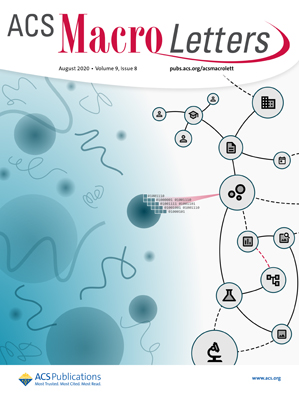嵌段共聚物胶束的量化融合动力学
IF 5.2
Q1 POLYMER SCIENCE
引用次数: 0
摘要
研究了嵌段共聚物胶束在稀溶液中的熔合动力学。研究了离子液体1-丁基-3-甲基咪唑四氟硼酸盐中的1,2-聚丁二烯-嵌段聚环氧乙烷胶束。离子液体是聚环氧乙烷的选择性溶剂,促进嵌段共聚物自组装成球形胶束。此外,用于电晕块的溶剂质量接近θ,从而减少了熔合的大空间位阻。用助溶剂制备了小的、动态捕获的胶束,随后通过在高温下的动态光散射来监测熔合动力学。小角度x射线散射和低温透射电镜量化了热退火后平均聚集数的显著增加,并证实形成了定义明确、更大的球形胶束。对于较高的退火温度,该过程分两步进行,第二步的松弛时间至少比第一步长一个数量级。有趣的是,第一步后的稳态胶束聚集数大约是初始值的两倍,第二步后的稳态胶束聚集数是初始值的四倍。这一结果强烈暗示了一种量化效应,即对于较大的胶束,聚变速率要慢得多,可能是由于增强的电晕拥挤。弛豫速率也是浓度的增加函数,与融合是主要机制相一致。本文章由计算机程序翻译,如有差异,请以英文原文为准。

Quantized Fusion Kinetics in Block Copolymer Micelles
The fusion kinetics of block copolymer micelles in dilute solutions have been investigated. As a model system, 1,2-polybutadiene-block-poly(ethylene oxide) micelles in the ionic liquid 1-butyl-3-methylimidazolium tetrafluoroborate have been studied. The ionic liquid is a selective solvent for poly(ethylene oxide), promoting the self-assembly of the block copolymer into spherical micelles. Furthermore, the quality of the solvent for the corona block is near-theta, thereby reducing the large steric barrier to fusion. Small, kinetically trapped micelles were prepared using a cosolvent, and the kinetics of fusion were subsequently monitored via dynamic light scattering at elevated temperatures. Small-angle X-ray scattering and cryo-transmission electron microscopy quantified significant increases in the mean aggregation number after thermal annealing and confirmed the formation of well-defined, larger spherical micelles. For higher annealing temperatures, the process occurs in two steps, with the relaxation time of the second step being at least an order of magnitude longer than the first. Interestingly, the steady-state micelles after the first step had approximately twice the starting aggregation number, and those after the second step had four times the original value. This result strongly suggests a quantization effect, where the rate of fusion is much slower for larger micelles, presumably due to enhanced corona crowding. The relaxation rate is also an increasing function of concentration, consistent with fusion being the dominant mechanism.
求助全文
通过发布文献求助,成功后即可免费获取论文全文。
去求助
来源期刊
CiteScore
10.40
自引率
3.40%
发文量
209
审稿时长
1 months
期刊介绍:
ACS Macro Letters publishes research in all areas of contemporary soft matter science in which macromolecules play a key role, including nanotechnology, self-assembly, supramolecular chemistry, biomaterials, energy generation and storage, and renewable/sustainable materials. Submissions to ACS Macro Letters should justify clearly the rapid disclosure of the key elements of the study. The scope of the journal includes high-impact research of broad interest in all areas of polymer science and engineering, including cross-disciplinary research that interfaces with polymer science.
With the launch of ACS Macro Letters, all Communications that were formerly published in Macromolecules and Biomacromolecules will be published as Letters in ACS Macro Letters.

 求助内容:
求助内容: 应助结果提醒方式:
应助结果提醒方式:


